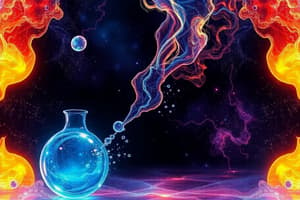Podcast
Questions and Answers
Which property describes solids?
Which property describes solids?
- They have a high density and a fixed shape. (correct)
- They have a fixed volume and adopt the shape of the container.
- Particles move randomly and quickly in all directions.
- They have low kinetic energy and are loosely packed.
Liquids have a fixed shape and volume.
Liquids have a fixed shape and volume.
False (B)
What is the process called when a solid turns into a liquid?
What is the process called when a solid turns into a liquid?
Melting
When a gas cools down, the particles lose energy and group together to form a __________.
When a gas cools down, the particles lose energy and group together to form a __________.
Match the following states of matter with their properties:
Match the following states of matter with their properties:
At what temperature range will a substance exist as a liquid?
At what temperature range will a substance exist as a liquid?
Particles in a solid have higher kinetic energy than particles in a liquid.
Particles in a solid have higher kinetic energy than particles in a liquid.
What happens to the intermolecular spaces of a substance as it melts?
What happens to the intermolecular spaces of a substance as it melts?
During ________, a gas is cooled and particles start moving slower.
During ________, a gas is cooled and particles start moving slower.
Match the following state changes with their descriptions:
Match the following state changes with their descriptions:
Study Notes
States of Matter
- Solids have a fixed shape and volume.
- Liquids have a fixed volume but take the shape of their container.
- Gases have no fixed shape or volume.
- Solids have high density, liquids have medium density, and gases have low density.
- The particles in solids vibrate in fixed positions, in liquids they move and slide past each other, and in gases they move randomly and quickly in all directions.
Changes of State
- Melting is when a solid changes into a liquid.
- It occurs at the melting point (m.p.).
- Freezing is when a liquid changes into a solid.
- It occurs at the same temperature as the melting point.
- Evaporation is when a liquid changes into a gas at the surface.
- It occurs over a range of temperatures below the boiling point.
- Boiling is when a liquid changes into a gas.
- It occurs at the boiling point (b.p.).
- Bubbles form within the liquid.
- Condensation is when a gas changes into a liquid.
- It occurs over a range of temperatures.
- Sublimation is when a solid changes directly into a gas.
- Deposition is when a gas changes directly into a solid.
The Kinetic Particle Theory
- All matter is made up of small particles.
- The particles are in constant random motion.
- There are spaces between the particles.
- There are attractive forces between the particles.
Heating and Cooling Curves
- Heating curves show how the temperature of a substance changes as it is heated.
- Cooling curves show how the temperature of a substance changes as it is cooled.
- The temperature remains constant during phase changes.
- This is because the heat energy is being used to overcome intermolecular forces, not to increase kinetic energy.
- The temperature increases in the regions where the substance is not changing state.
- This is because the heat energy is being used to increase kinetic energy, not to overcome intermolecular forces.
Pure vs Impure Substances
- Pure substances have fixed melting and boiling points.
- On heating curves, phase changes are represented by horizontal lines.
- Impure substances melt and boil over a range of temperatures.
- On heating curves, phase changes are represented by sloping lines.
Volume of Gases
- The volume of a gas can be changed by changing the temperature or pressure.
- Increasing the pressure decreases the volume (inversely proportional).
- Increasing the temperature increases the volume (directly proportional).
- These changes are due to the large intermolecular spaces in gases.
Diffusion
- Diffusion is the movement of particles from an area of high concentration to an area of low concentration.
- It is the movement of particles down a concentration gradient.
- It continues until equilibrium is reached.
- It occurs in fluids (liquids and gases) but not in solids.
- The rate of diffusion is faster at higher temperatures and for particles with lower relative molecular masses.
Diffusion Rate and Molecular Mass
- Lighter particles diffuse faster than heavier particles.
- For instance, ammonia molecules (NH3) diffuse faster than hydrogen chloride molecules (HCl) because they are lighter.
Diffusion Rate and Temperature
- The higher the temperature, the faster the diffusion rate.
- This is because particles have more kinetic energy at higher temperatures.
Studying That Suits You
Use AI to generate personalized quizzes and flashcards to suit your learning preferences.
Related Documents
Description
Explore the essential concepts of states of matter, including solids, liquids, and gases. Understand the process of changing states through melting, freezing, evaporation, boiling, and condensation. This quiz will help reinforce your knowledge of the properties and behaviors of different states of matter.




